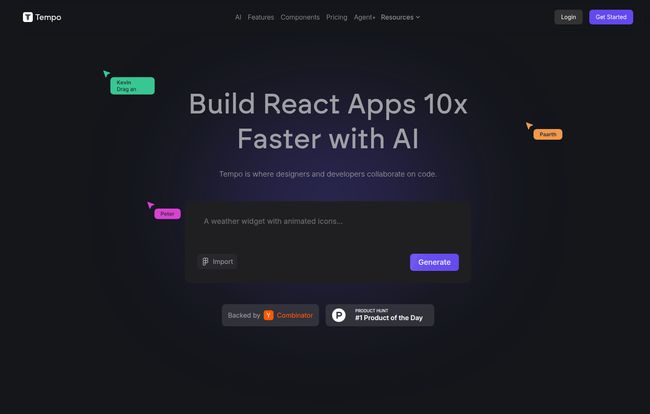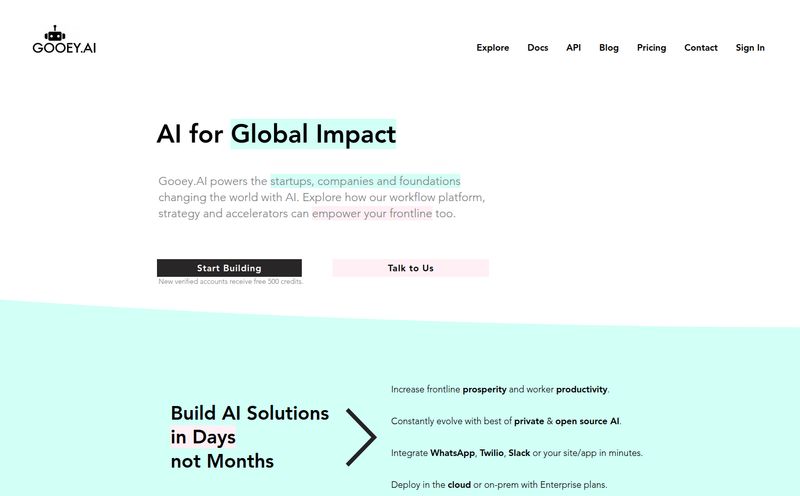I still get a cold sweat thinking about it. It was a Tuesday. The designer, a brilliant but meticulously particular artist, sent over the 'final_final_v6.fig' file. The developer, a caffeine-fueled code wizard, took one look, sighed the sigh of a thousand slain pixels, and said, "This is gonna take a week just to translate." The button was 2 pixels off, the font-weight was a custom value that didn't exist, and the responsive behavior was... optimistic. This is the dance. The painful, time-sucking, soul-crushing dance between design and development we've all been doing for years.
We've tried everything. Design systems, detailed handoff docs, endless Slack threads. They help, but they're just bandaids on a fundamental workflow problem. The design is a picture of the app; the code is the actual app. They're two different languages. But what if they weren't? What if you could design... with code? Not by writing it line-by-line, but by moving things around visually, like in Figma, except every move you make writes real, production-ready React code. That’s the wild promise of Tempo.
So What Exactly is This Tempo Thing?
Let's get this straight: Tempo is not another design tool that exports janky code. I've seen those. We've all seen those. They give you a mess of absolute-positioned divs that you have to rewrite from scratch. No, Tempo is different. It’s a code-first platform that uses a visual interface. Think of it less like Figma and more like a visual abstraction layer sitting directly on top of your codebase. It’s a design tool. But it’s also an IDE. It's a strange, wonderful hybrid that feels a bit like the future.
It's built specifically for the modern web stack—optimized for React, Vite, and Tailwind CSS. So, if that's your jam, you're in the right place. The entire idea is to close the loop. Instead of a one-way street from design to dev, it's a collaborative roundabout where designers, developers, and even PMs can work on the same source of truth: the code itself.

Visit Tempo
The AI-Powered Magic Wand for Your UI
Okay, here's where it gets really interesting. Tempo has an AI assistant baked right in. You've probably used GitHub Copilot or ChatGPT to spit out code snippets. This is like that, but for whole components and layouts. You can literally just… ask it for things. The demo shows a prompt like,
Can you turn this grid design into a functional job board app?
And it just... does it. It generates the React components, styles them with Tailwind, and makes it interactive.
This isn't about replacing developers. It's about obliterating the boring, repetitive parts of their jobs. Why spend three hours scaffolding a basic card layout with placeholder data when an AI can do it in 30 seconds? This frees up precious engineering time for what actually matters: complex logic, performance optimization, and building features that actually move the needle. It's an incredible accelerator for prototyping and getting V1 of a feature out the door.
A Tool Designers and Devs Might Actually Agree On
The eternal conflict might just have a ceasefire. Tempo seems to have thought long and hard about making both sides of the house happy. I'm genuinely impressed.
For the Designers: A Familiar Playground with Superpowers
If you're a designer who lives in Figma, the Tempo interface will feel strangely familiar. You have a canvas, you can drag and drop elements, and there's a properties panel on the right to tweak styles. You can adjust padding, colors, fonts, you name it. The crazy part? You're not drawing static vectors. You're directly manipulating live React components. When you change the corner radius of a button, you're not just changing a shape; you're updating the Tailwind CSS class in the code. This is huge. It means what you see is literally what you get. No more broken promises during handoff.
For the Developers: Control Without the Tedium
Alright, devs, I see you. You're skeptical. A visual tool messing with your pristine code? Sounds like a nightmare. But hold on. Tempo plays nice. One of its killer features is that it works with any existing React codebase. You can point it at your current project and start using it without a massive rewrite. It's not an all-or-nothing proposition.
Even better, it integrates directly with your existing workflow. You can pop open any component in VSCode, make your changes the old-fashioned way, and see them reflected back in the Tempo visual editor. It all syncs through GitHub. You maintain full control over your code, your hosting, and your deployment pipeline. Tempo just becomes a powerful new interface for building and iterating on the frontend part of that code.
Let's Talk Turkey: Tempo's Pricing Structure
So, what's all this magic cost? The pricing is... interesting. It ranges from totally free to "I might need to sell a kidney." They've structured it to fit different needs, from solo hackers to venture-backed startups.
Here’s a quick breakdown I've put together:
| Plan | Price | Best For | Key Feature |
|---|---|---|---|
| Free | $0 / month | Hobbyists, students, trying it out | 30 AI prompts per month (max 5 a day). Error fixes are free! |
| Pro | $30 / month | Freelancers, professionals, small teams | 150 prompts, full agent access, can buy more prompts. |
| Agent+ | $4,000 / month | Startups & companies that want to outsource front-end work | Tempo's team builds 1-3 features for you per week. |
The free plan is perfectly generous for giving it a real spin. The Pro plan feels like the sweet spot for most professional users. That Agent+ plan, though... that's a whole different beast. It's not just a software license; it’s basically a development-team-as-a-service. For $4k a month, their team of engineers and designers will build features for you with a 48-72 hour turnaround. It's wild. It's a premium, high-touch service for teams that have more money than time. It's like hiring a Michelin-star chef to cook in your kitchen—it's not cheap, but the results are probably incredible.
The Good, The Bad, and The Code-y
No tool is perfect, right? After digging in, here's my honest take. The speed is undeniable. The AI-powered generation and the visual editor truly can accelerate development, especially for UI-heavy applications. The collaboration aspect is its biggest strength; it creates a shared language and workspace that could save teams hundreds of hours in miscommunication.
On the flip side, the prompt limits on the Free and Pro plans might feel a bit tight if you become heavily reliant on the AI. And while the visual editor is slick, let's be real: for seriously advanced customizations and logic, you're going to need to be comfortable diving into the React code. This isn't a no-code tool, nor does it pretend to be. It's a tool for people who build for the web, designed to make their lives easier.
My Final Take: Is Tempo a Fad or the Future?
I've seen a lot of tools come and go. A lot of hype cycles. But Tempo feels different. It feels like a genuine step forward in how we think about building software. It's part of a larger trend, with tools like Vercel's v0 also exploring this space of generative UI. The idea that we can move from low-fidelity wireframes to high-fidelity, interactive, coded prototypes in minutes instead of weeks is powerful.
Will it replace Figma? For initial brainstorming and pure design ideation, probably not. Figma is still king there. But for the phase where design meets reality—the build, iterate, and maintain phase—Tempo is a ridiculously compelling alternative. It's not just about building 10x faster; it's about working 10x smarter by closing the gap that has slowed us down for so long.
In my opinion, it's not a fad. It's a very smart, very powerful glimpse of the future of front-end development.
Frequently Asked Questions about Tempo
Does Tempo work with frameworks other than React?
As of now, Tempo is specifically optimized for React, particularly with Vite and Tailwind CSS. The team might expand to other frameworks like Vue or Svelte in the future, but for now, you'll get the best experience within the React ecosystem.
Is the AI-generated code actually production-ready?
It's an excellent starting point. The code is generally clean and follows best practices for React and Tailwind. However, like any AI-generated code, it's always a good idea to have a human review it, especially for complex components. Think of it as a super-powered junior dev who gives you a fantastic first draft that you can then refine.
Can I import my existing Figma designs into Tempo?
Tempo's approach is 'code-first' rather than 'design-import'. While there isn't a direct Figma-to-Tempo import button that magically converts everything, you can use your Figma designs as a visual reference to quickly rebuild them in Tempo using its visual editor and AI prompts. The process is so fast that it's often easier than dealing with a messy import.
How does the Agent+ plan actually work?
The Agent+ plan is a full-service model. You submit feature requests or designs, and Tempo's internal team of engineers and designers builds them for you directly in your codebase. They guarantee quality and a 48-72 hour turnaround. It's essentially outsourcing your front-end feature development to a dedicated, expert team.
What are 'prompts' and why are they limited?
A 'prompt' is a single request you make to the Tempo AI, like "create a login form" or "change this button to green." These AI computations are resource-intensive, so the limits are in place to manage server costs. Importantly, asking the AI to fix an error it made does not count against your prompt limit, which is a very fair policy.
The chasm between design and code has always been a source of friction, cost, and delay. A tool like Tempo doesn't just pave it over; it builds a whole new city in the middle where everyone can collaborate. It’s an ambitious goal, but from what I've seen, they're well on their way to pulling it off. It’s definitely a tool to watch in the coming year.



